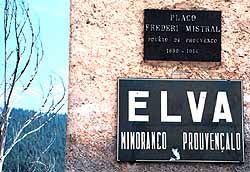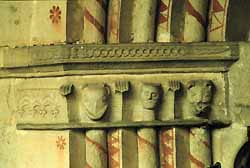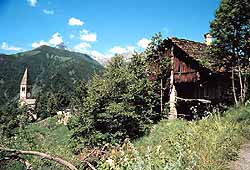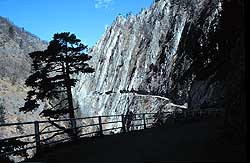Elva

È un paese dell’alta Val Maira ed è costituito da più di venti borgate; il capoluogo è Serre, a quota 1637 m, vi è il municipio, la chiesa, la scuola elementare, un ristorante, un posto tappa GTA, un negozio di alimentari e un caseificio; gli abitanti sono poco più di un centinaio.
Elva si può raggiungere passando dalla Val Varaita, attraverso il Colle di Sampeyre, a 2200 m (ovviamente quando non c’è la neve), dalla tortuosa strada di 17 km da Stroppo, detta delle Cavalline, oppure dalla strada del Vallone. Quest’ultima è stata aperta soltanto nel 1956, impiegando tonnellate di dinamite e a prezzo di molte vite umane; si tratta di un percorso vertiginoso scavato nella roccia viva di un canyon (in dialetto occitano coumbo), nel quale, 300 metri sotto scorre il torrente. In inverno questa strada sovente viene bloccata dalle valanghe. 
Le varie borgate sono poste su ampi pianori soleggiati, costituiti da pascoli.
La parrocchiale di Elva, in stile romanico, e col quattrocentesco campanile gotico, è famosa per il suo ciclo di affreschi del ‘400 ad opera di Hans Clemer, detto il "Maestro d’Elva". Interessante anche il portale in pietra composto da cinque archi concentrici, con scolpiti sui capitelli teste e scene medievali, il fonte battesimale quattrocentesco, e molte sculture interne.
Molto belle anche alcune costruzioni in pietra, sulle cui facciate – generalmente esposte a sud o sud-est – vi sono colonne in pietra a sezione circolare, che servono a sostenere gli ampi ballatoi in legno, che avevano la funzione di essiccatoi (per castagne, legname, fieno); tra di esse vi è la "casa della meridiana", in via di ristrutturazione.
Elva è conosciuta anche per due mestieri tipici dell’emigrazione stagionale alpina:
- gli anciuìe (acciugai): verso la fine dell’800 e fino alla seconda guerra mondiale, alcuni uomini del paese - e di quelli vicini - verso la fine di settembre, dopo la semina si recavano nei paesi della riviera, dove acquistavano da un grossista un carico di acciughe e merluzzo, che andavano poi a rivendere nelle campagne della provincia di Torino, Asti, Milano; lo strumento di lavoro era un carretto leggero e robusto, che acquistavano da artigiani specializzati a Tetti di Dronero; questi ambulanti ritornavano a casa in primavera per riprendere il lavoro dei campi;
- i cavìe (commercianti di capelli): questa attività è incominciata all’inizio dell’’800 ed è terminata negli anni sessanta; i capellari giravano le valli e i paesi dell’Italia settentrionale a cercare donne e ragazze disposte a cedere le loro capigliature per la produzione di parrucche dando loro in cambio vestiti, oppure pezze di tela o lana, talvolta denaro; molte ragazze dovevano a malincuore cedere per bisogno i loro capelli, che venivano valutati in base alla lunghezza, al colore, alla lucentezza. Successivamente si è anche incominciato a raccogliere i cavèi dal pentu, cioè quei capelli che naturalmente cadevano ogni giorno o rimanevano impigliati nei pettini; le donne li conservavano in sacchettini di tela e periodicamente li davano al commerciante, che li portava in appositi laboratori di Elva, dove altre persone, soprattutto donne, dovevano dividerli e sistemarli. Quelli tagliati di solito erano in trecce; i cavèi dal pentu invece dovevano essere districati, lavati e divisi in base alla lunghezza, e inoltre distesi e con le radici dallo stesso lato, poi composti in matasse; venivano poi venduti soprattutto in Francia, dove venivano poi confezionate le parrucche.
|
Elva

Elva is an isolated village of the high Maira valley constituted by more than twenty hamlets; the chief town is Serre, at an altitude of 1637 m, with the municipality, the church, the primary school, a restaurant, a GTA (the Great Alps Crossing trail) halting stage refuge, a food shop and a dairy; the inhabitants are a little more than one hundred.
It is possible to reach Elva from the Varaita valley through the Sampeyre pass (2200 m of altitude, obviously when it is snow-free), by the meandering 17 km long road starting from Stroppo (nicknamed as "of the little mares") or by the road of the Vallone. This last one was opened only in 1956, with the help of tons of dynamite and at the coast of many human lives; it is a dizzy way carved into the rock of a canyon (canyon is in the local language coumbo) where the river flows 300 meter below. This road is often stopped by the avalanches.
The various hamlets lie on large sunny plateaux, mostly pastures.
The parish church is in Romanesque style, with a gothic XV century bell tower. It is famous for the XV cent. frescos of Hans Clemer, so called the "Elva master". Very interesting the stone portal (constituted by five concentric arches, with middle-age heads and scenes carved inside), the font and the various inner statues.
Various stone buildings are also noticeable: on their fronts, generally exposed southward, it is possible to find stone round columns, holding the large wooden galleries, where wood, hay and chestnuts were dried. Among these houses the "house of the sun-dial" is being restored.
Elva is also known for two jobs typical of the seasonal alpine emigration:

- the anciuìe (the sellers of salted anchovies). From the end of the XIX century till the second world-war, some men of the village, around the end of September, reached after the sowing the villages along the sea to buy form a wholesaler a load of anchovies and cod, in order to resell them along the country-side in the Turin, Asti and Milan provinces. They utilised a strong light barrow, bought from some specialised craftsmen at Tetti near Dronero; these costers returned back to home in spring, to retake their farm job;
- the cavìe (the hair traders): this activity started at the beginning of the XIX century and stopped in the '60s; the hair traders turned around the valleys and the villages of the northern Italy to find girls and women ready to give their hair to produce wigs in exchange of dresses or clothes, sometimes money; many girls, needing money, reluctantly gave away their hair, which were valued basing on the length, the colour, the brilliancy. After that they also started to pick up the cavèi dal pentu (the hair of the comb); women kept it in a little cloth-bag, periodically giving it to the hair trader, who brang the hair to a specific workroom at Elva, were local women had to divide and put it in place. Normally the cut hair where in braids, while "the hair of the comb" must be untied, washed and divided according to the length, then disposed in skeins. At the end the hair was sold in France, where wigs were made.
|